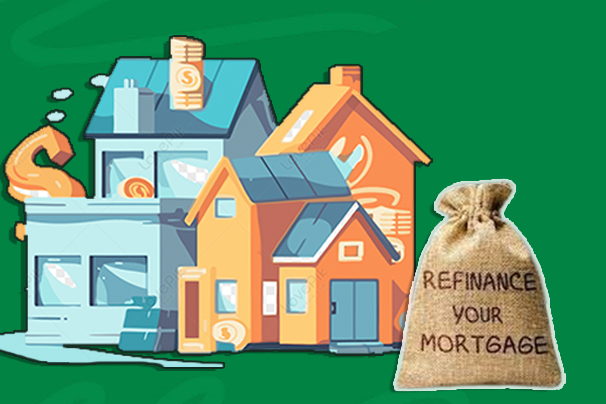It’s a big decision to refinance your mortgage and to decide the type of refinance to conduct. There are numerous types of mortgage refinance options available, including rate-and-term and cash-out refinance. The most typical, rate-and-term, is taking out a new loan with a different interest rate, loan term, or both, and replacing your existing mortgage.

Moreover, several mortgage types allow for refinance options, which eliminate the need for an appraisal or thorough underwriting. However, your goals determine which refinance option is best for you. Furthermore, a refinance or rate-and-term refinance can be a good option for you if all you are looking for is a reduced rate.
Types of Mortgage Refinance Options
There are various types of mortgage refinance options. Additionally, the kind of loan that a borrower chooses to take out is determined by their needs. Moreover, these types of mortgage refinance options include:
Rate-and-term refinance
The most typical kind of refinancing is rate-and-term refinancing. During this process, your current mortgage is replaced with a new one that may have a different interest rate, a different loan term (the amount of time you have to pay it back), or both. If a homeowner wants to lower their interest rate, the best option is a rate-and-term refinance.
Moreover, you may be able to save a lot of money on both your monthly payments. Additionally, the total amount of interest you pay if you can refinance to a better rate. Also, enter your information into our refinance calculator to see how your payments might be affected by a rate decrease. Furthermore, you have the option to refinance into a shorter loan at a lower interest rate to pay off your mortgage sooner and pay less interest overall. However, this does not affect the total amount you owe, so your monthly payments may increase.
Cash-out refinance
With a cash-out refinance, you can fund different expenses by using the equity in your home. This could lower your monthly payments overall. This is borrowing more money for a new mortgage loan than what is owed on the existing mortgage and putting the additional money toward something else. This includes remodeling or other home upgrades. You have to satisfy all credit and debt-to-income (DTI) ratio requirements set forth by your lender to be eligible for a cash-out refinance. Additionally, you need to have a minimum of 20% or more in equity in your house. However, this varies according to the lender.
Streamline Refinance
Homeowners with government-backed mortgages, such as FHA, VA, or USDA, may qualify for a streamlined refinance. Also, streamlined refinances are intended to be simpler and faster than rate-and-term refinances. This is because there is less paperwork and no need for a property evaluation. In addition, the two categories of streamlined refinance are credit-qualifying and non-credit-qualifying refinances.
A credit check is required for a credit-qualifying streamline refinance. In most cases, a credit check is not required for non-credit qualifying streamline refinancing. You will still have a loan with the same government program after this kind of refinance is finished, but the interest rate will change.
Cash-out refinancing
Cash-outs are frequent when the value of the underlying asset used to secure the loan has increased. In exchange for a larger loan amount (and frequently a higher interest rate), the value or equity in the asset is withdrawn. If an item’s paper value increases, it can be accessed through a loan instead of selling it. With this option, the total loan amount is increased. However, the borrower still has ownership of the item and has instant access to cash.
Cash-in refinancing
A cash-in refinance, as opposed to a cash-out refinance, entails the borrower contributing a sizeable amount of money to the refinancing process as opposed to withdrawing it. You can lower your loan-to-value ratio (LTV) and raise your home’s equity by paying down a sizable chunk of your mortgage. However, this could lead to lower monthly payments or a cheaper interest rate. A cash-in refinance is typically the best option. This is for those with underwater mortgages or homeowners who do not have access to a sizable amount of home equity. No-Closing-Cost
NST Refinance
You might be able to refinance without having to pay a large sum of money upfront if closing costs are a worry for you. With this kind of refinance, you can accept a higher interest rate in return for no additional fees, or you can apply the closing expenses to the principal balance. In any case, if you lack the cash on hand to refinance your mortgage, a no-closing-cost refinance can be the best option.
Conventional refinance
Conventional loans offer the highest borrowing requirements but usually the lowest rates. This usually indicates that you need a debt-to-income (DTI) ratio of 45% or less and a credit score of at least 620. It may be possible to avoid paying costly FHA mortgage insurance if you refinance from an FHA loan to a conventional loan.
Moreover, on a traditional rate-and-term or cash-out refinance, you might also be qualified for an appraisal waiver. This can expedite the loan application process and spare you the $300 to $500 that a house appraisal typically costs.
How to Choose a Mortgage Refinance Option
There are advantages and disadvantages to each type of mortgage refinance option. And one approach may be better than another in helping you reach your objectives. Furthermore, you should consider the below as you assess your options:
- Your length, interest rate, and mortgage payment.
- Your financial circumstances, such as your debt-to-income ratio (DTI) and LTV ratio.
- Your financial objectives and how refinancing fits into them.
- The amount of equity you own in your house.
Furthermore, determine the amount of closing fees and new monthly payments that you can afford to pay. Also, use a break-even calculator to find out how long it will take you to recoup your closing costs if you don’t intend to sell the house shortly.



